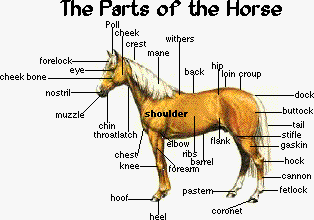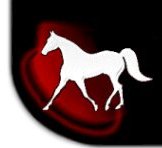|
Equine
Vaccinations | Anthrax in Equines | Horse Temperature | Disease
Symptoms
Mare
Heat Cycles | Parasites/Worms | Parts of Horse | West Nile
Virus
Breeding
Mares & Horse Heat Cycles
| Foaling
Tips - Mares & Foals
Care
& Management of the Young Foal
Suggested
Vaccinations For Horses
| Disease |
Type
Vaccine
|
Administration |
Earliest
Age Of Initial vaccine |
2nd
Vaccine Interval |
Revaccination
Interval |
| Tetanus |
killed bacterin toxoid
|
intramuscular
(in the muscle) |
3 months |
1 to 2 months later |
yearly |
Encephalomyelitis
Eastern/Western |
killed virus |
intramuscular |
3 months |
1 to 2 months later |
yearly, before insect
season |
Equine
Influenza |
killed virus |
intramuscular |
3 months |
1 to 2 moths later |
every 3 months during
epidemic/before shipping |
| Rhinopneumonitis* |
killed virus |
intramuscular |
3 months |
1 to 2 months later |
every 3
months during
epidemic/before shipping |
Strangles
Equine Distemper |
killed bacterin |
intramuscular |
3 months |
1 month later |
every 3 months during
epidemic/before shipping |
| Rabies |
killed virus |
intramuscular |
3 months |
1 time per year |
yearly |
| Potomac Horse Fever |
killed bacterin |
intramuscular |
3 months |
3 weeks later |
yearly |
*Pregnant mares should be vaccinated for Rhinopneumonitis during
the 5th, 7th and 9th months of gestation.
Back
to Top
Equine
Disease Symptoms
| Disease |
General Signs |
Spread |
| Tetanus |
Difficulty
eating or
walking, overreaction to noise,
stiffness, elevation of the 3rd eyelid.
|
Not
contagious; caused
by punctures and wound infection.
|
| Encephalomyelitis |
Often
fatal; fever,
staggering, circling, head
pressing, depression and sleepiness.
|
Not
contagious, but
spread by mosquitoes. |
| Equine
Influenza |
Rarely
fatal; cough,
loss of appetite, fever,
depression, muscle soreness, discharge from the eyes &
nose. |
Very
contagious; keep
affected animals
isolated. |
| Rhinopneumonitis |
Respiratory
distress;
nasal discharge, cough,
fever; causes abortion in pregnant mares. |
Very
contagious; keep
affected animals
isolated. |
| Strangles |
Fever,
swollen jaw
glands, loss of appetite,
cough, nasal discharge, can cause abortion in pregnant mares. |
Very
contagious; keep
affected animals
isolated. |
| Potomac
Horse Fever |
Lethargy,
anorexia,
fever, colic, laminitis,
colitis, and diarrhea. |
Spread
during insect
season, vector unknown. |
Back
to Top
Parts
of the Horse

Back
to Top
West
Nile Virus
Signs of West Nile virus in horses: These symptoms can be confused with
rabies, EPM ("Possum Disease), equine encephalitis, and other serious
neurological diseases. If you see any of these signs in your horse,
please see your veterinarian
immediately. Stumbling or tripping ~ Muscle weakness or twitching ~
Partial paralysis ~ Loss of appetite ~ Depression or lethargy ~ Head
pressing or tilt ~ Impaired vision ~ Wandering or circling ~ Inability
to swallow ~ Inability to stand up ~ Fever ~ Convulsions ~ Coma.
Click on the links below for more West Nile information:
CDC West Nile Virus Home Page
CDC West Nile Virus in Horses FAQ
Back
to Top
Anthrax
in Horses
Anthrax is a bacterial disease caused by the organism Bacillus
Anthracis. Horses most commonly show septicemia with enteritis and
colic. Most cases are reported during the warm summer months.
Vaccination is only recommended in enzootic areas of the country, (i.e.
South Dakota, Louisiana, Texas, Missouri, California, and Arkansas). In
the case of an outbreak, only those animals
not exhibiting clinical signs should be vaccinated.
Anthrax
as a Weapon of Terrorism
Centers
for Disease Control - Anthrax
Back
to Top
Mare
Heat Cycles
We have found that most healthy mares come into heat every 21-22 days.
21 to 22 days from the time she comes into heat, she should start into
heat again. Some mares may vary from 18 to 31 days in their heat
cycles.
Ovulation
or the fertile time for the mare occurs 24 to 48 hours before
the mare goes out of heat. So, no matter how long she is in heat she
cannot become pregnant until shortly before she goes out of heat. Most
mares are in heat for about 5 to 7 days. A healthy stallion's sperm
lives about 24 hours in the mares genital tract, so in order to get the
mare to settle in foal it is necessary to have the stallion cover her
shortly before she goes out of heat. We usually breed mares on the
second day of their heat cycles, and then breed them every other day
until they go out of heat.
Most
mare's foal heat, (the first heat cycle after foaling) will
usually start about 9 days after the foal is born, but depending on the
individual mare, it can start from 4 to 18 days later. She can be bred
back at this time if she foaled clean with no problems or
complications. The second heat after foaling usually starts 18 to 21
days after the foal heat.
Managing Heat Cycles in Mares
Culture Test Mares
Back
to Top
Parasites
& Worms
Internal parasites are a major threat to the health,
strength and vitality of every horse. Clinical and/or
sub clinical parasitism exacts a staggering toll on the health of
nearly every horse. Fortunately, horse owners have the power to prevent
parasite damage.
Thousands of eggs and larvae of dangerous parasites like large
strongyles, small strongyles, roundworms and pinworms are ingested
daily by horses. The typical life cycle of internal parasites in the
horse begins when infective larvae or eggs containing larvae are
ingested. Damage is done to the intestines, and larval migration may
damage other organs as well. Over the following weeks and months, the
larvae develop and mature until they become egg-producing adults. The
thousands of eggs produced by the adult worms are passed back into the
environment where they start the cycle all over again.
Equine Internal Parasites
World of Horses
Back
to Top
Horse
Temperature
A
horse's normal rectal body temperature is approximately 100.5 degrees.
Temperatures of 102 degrees or more generally indicate an infection,
which needs attention.
The normal breathing rate for a horse at rest is 12-15 breaths per
minute. Breathing rate can be determined by watching the nostrils or
flank.
Rapid, shallow breathing at rest often means a horse needs
medical attention.
The normal resting heart rate for a horse is 35-40 beats per minute.
The rate will increase when a horse is excited or exercising. A resting
heart or pulse rate of 50 or higher means the horse is in physical
distress. The heart rate can be determined by monitoring it at the
artery that crosses under the jaw, or by feeling the heart beat. To
feel the beat put your hand under the horse's left elbow.
Back
to Top
The above tips are not meant as a diagnosis, treatment advise or
replacement for the medical advisement of your veterinarian. It is
offered as a general informational resource based on personal
experience and study.

|
Site Navigation
Home
Site
Search
Free Graphics
Animated
GIFS
Free
Clipart
Free
Ecards
FB
Timeline Covers
Large
File Clipart
Free
Backgrounds
Background
Sets
Matching
Sets
Buttons
MySpace
Graphics
Web
Fun & Help
Coloring
Pages
Flip
Text Tool
How
to Copy & Paste
Fun
& Games
Emotions/Emoticons
HTML
Tester
Jigsaw
Puzzle
Horse
Pages
Horse
Health
Breeding/Heat
Cycles
Foaling
Tips
Foal
Care
Foxtrotter
Training
Humor
Buying Guide
What
is Homozygous
Shopping
Pages
Gift
Shops
Horse
Posters
More
Pages
Missing
Children
Award
Winning Sites
Apply
Award
Links
Webrings
Site
Map |



